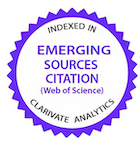Bactérias ácido lática para inibir a produção de biofilme de Salmonella Heidelberg em superfícies de polisestireno
DOI:
https://doi.org/10.1590/1809-6891v25e-76376EResumo
Salmonella spp. é uma das principais causas de gastroenterite em todo o mundo. Salmonella Heidelberg é um patógeno emergente associado com surtos com multirresistência antimicrobiana vinculados aos produtos avícolas. A sua alta persistência no ambiente pode estar associada com sua
habilidade de aderir a diferentes superfícies e formar biofilmes. Devido ao aumento da resistência antimicrobiana em todo o mundo, os pesquisadores têm investigado o uso de bactérias acido láticas (BAL) como um controle biológico e de microrganismos patogênicos. O objetivo deste estudo foi avaliar a habilidade de BAL no controle de biofilmes produzidos por S. Heidelberg em placas de poliestireno. Foi avaliada a atividade antimicrobiana in vitro de nove BAL, todas pertencentes ao gênero Lactobacillus, na inibição e na remoção de biofilmes produzidos por S. Heidelberg. A formação de biofilme só ocorreu quando a BAL1 (Lactobacillus salivaris) foi utilizada. Todos os outros tratamentos demonstraram atividade antimicrobiana. Entretanto, a BAL não foi capaz de reduzir a contagem bacteriana. Os resultados obtidos demonstram que BAL são capazes de prevenir ou retardar a formação de biofilme por S. Heidelberg em superfícies de poliestireno e podem ser utilizadas em estudos in vivo para determinar o seu potencial alternativo no controle deste patógeno na indústria de alimentos.
Downloads
Referências
World Health Organization. Food Safety. [Internet] 2023. [cited 2023, Jan 07]. Available from: https://www.who.int/news-room/fact-sheets/detail/food-safety
Centers for Disease Control and Prevention. Making food safer to eat: Reducing contamination from the farm to the table. 2011. [cited 2023, Apr 05]. Available from: www.cdc.gov/vitalsigns/foodsafety/
Baptista D. 2022. Palestra: Dados de controle oficial de Salmonella no PNSA – MAPA. In: Simpósio FACTA sobre Salmonella. Campinas, Brazil.
Etter AJ, West AM, Burnett JL, Wu ST, Veenhuizen DR, Ogas RA, Oliver HF. Salmonella enterica subsp. enterica serovar Heidelberg food isolates associated with a salmonellosis outbreak have enhanced stress tolerance capabilities. Applied and Environmental Microbiology. 2019;85(16):e01065-19. Disponível em: http://doi.org/10.1128/AEM.01065-19
Tiba-Casas MR, Camargo CH, Soares FB, Doi Y, Fernandes SA. Emergence of CMY-2-producing Salmonella Heidelberg associated with IncI1 plasmids isolated from poultry in Brazil. Microbial Drug Resistance. 2019;25(2):271-276. Disponível em: http://doi.org/10.1089/mdr.2018.0044
Borges KA, Furian TQ, Souza SN, Menezes R, Tondo EC, Salle CTP, Moraes HLS, Nascimento VP. Biofilm formation capacity of Salmonella serotypes at different temperature conditions. Pesquisa Veterinária Brasileira. 2018;38(1):71–76. Disponível em: https://doi.org/10.1590/1678-5150-PVB-4928
Borsoi A, Santos LR, Rodrigues LB, Moraes HLS, Salles CTP, Nascimento VP. Behavior of Salmonella Heidelberg and Salmonella Enteretidis strains following broiler chick inolucation: evalaation of cecal morphometry, liver and cecum bacterial counts and fecal excretion patterns. Brazilian Journal of Microbiology. 2011;42:266-273. Disponível em: https://doi.org/10.1590/S1517-83822011000100034
Webber B, Oliveira AP, Pottker ES, Daroit L, Levandowski R, Santos LR, Nascimento VP, Rodrigues LB. Salmonella Enteritidis forms biofilm under low temperatures on different food industry surfaces. Ciencia Rural. 2019. 49(7):e20181022. Disponível em: https://doi.org/10.1590/0103-8478cr20181022
Gieraltowski L, Higa J, Peralta V, Green A, Schwensohn C, Rosen H, Libby T, Kissler B, Marsden-Haug N, Booth H, Kimura A, Grass J, Bicknese A, Tolar B, Defibaugh-Chávez S, Williams I, Wise M. National outbreak of multidrug resistant Salmonella Heidelberg infections linked to a single poultry company. PLoS ONE. 2016;11(9):e0162369. Disponível em: https://doi.org/10.1371/journal.pone.0162369
Nisar M, Kassem II, Rajashekara G, Goyal SM, Lauer D, Voss S, Nagaraja KV. Genotypic relatedness and antimicrobial resistance of Salmonella Heidelberg isolated from chickens and turkeys in the Midwestern United States. Journal of Veterinary Diagnostic Investigation. 2017;29(3):370-375. Disponível em: https://doi.org/10.1177/1040638717690784
Lucca V, Borges KA, Furian TQ, Borsoi A, Salle CTP, Moraes HLS, Nascimento VP. Influence of the norepinephrine and medium acidification in the growth and adhesion of Salmonella Heidelberg isolated from poultry. Microbial Pathogenesis. 2020;138:103799. Disponível em: https://doi.org/10.1016/j.micpath.2019.103799
Merino L, Procura F, Trejo FM, Bueno DJ, Golowczyc MA. Biofilm formation by Salmonella sp. in the poultry industry: Detection, control and eradication strategies. Food Research International. 2019;119:530–540. Disponível em: https://doi.org/10.1016/j.foodres.2017.11.024
Wang H, Ye K, Wei X, Cao, J, Xu X, Zhou G. Occurrence, antimicrobial resistance and biofilm formation of Salmonella isolates from a chicken slaughter plantin China. Food Control. 2013;33:378–384. Disponível em: https://doi.org/10.1016/j.foodcont.2013.03.030
Gómez NC, Ramiro JMP, Quecan BXV, Franco BDGM. Use of potential probiotic Lactic Acid Bacteria (LAB) biofilms for the control of Listeria monocytogenes, Salmonella Typhimurium, and Escherichia coli O157:H7 biofilms formation. Frontiers in Microbiology. 2016;7. Disponível em: https://doi.org/10.3389/fmicb.2016.00863
Monteiro G, Rossi D, Valadares Júnior E, Peres P, Braz R, Notário F, Gomes M, Silva R, Carrijo K, Fonseca B. Lactic Bacterium and Bacillus sp. biofilms can decrease the viability of Salmonella Gallinarum, Salmonella Heidelberg, Campylobacter jejuni and methicillin resistant Staphylococcus aureus on different substrates. Brazilian Journal of Poultry Science. 2021;23(2). Disponível em: https://doi.org/10.1590/1806-9061-2020-1408
Sabo SDS, Mendes MA, Araújo EDS, Muradian LBDA, Makiyama EN, Leblanc JG, Borelli P, Fock RA, Knöbl T, Oliveira RPDS. Bioprospecting of probiotics with antimicrobial activities against Salmonella Heidelberg and that produce B-complex vitamins as potential supplements in poultry nutrition. Scientific Reports. 2020;10(1). Disponível em: https://doi.org/10.1038/s41598-020-64038-9
Hill C, Guarner F, Reid G, Gibson GR, Merenstein DJ, Pot B, Morelli L, Canani RB, Flint HJ, Salminen S, Calder PC, Sanders ME. The international scientific association for probiotics and prebiotics consensus statement on the scope and appropriate use of the term probiotic. Nature Reviews Gastroenterology & Hepatology. 2014;11(8):506–514. Disponível em: https://doi.org/10.1038/nrgastro.2014.66
Bogéa JS, Manto L, Santos JS, Santos LF, Gotardo FM, Rodrigues LB, Santos LR. Lactic Acid Bacteria against Listeria monocytogenes. Acta Scientiae Veterinariae. 2021;9. Disponível em: https://doi.org/10.22456/1679-9216.118224
Castellano P, Ibarreche MP, Massani MB, Fontana C, Vignolo, GM. Strategies for pathogen biocontrol using Lactic Acid Bacteria and their metabolites: a focus on meat ecosystems and industrial environments. Microorganisms. 2017;5(3):38. Disponível em: https://doi.org/10.3390/microorganisms5030038
Bergey's Manual of Systematic Bacteriology. 2nd ed. New York: Springer; 2015. 160p.
Gong C, Jiang X. Application of bacteriophages to reduce Salmonella attachment and biofilms on hard surfaces. Poultry Science. 2017;96(6):1838-1848. Disponível em: http://doi.org/10.3382/ps/pew463
Stepanović S, Cirković I, Ranin L, Svabić-Vlahović M. Biofilm formation by Salmonella spp. and Listeria monocytogenes on plastic surface. Letters in Applied Microbiology. 2004;38:428-432. Disponível em: https://doi.org/10.1111/j.1472-765x.2004.01513.x
Milles AA, Misra SS. The estimation of the bacterial power of the blood. The Journal of Hygiene.1938;38:732-749.
Bridier A, Sanchez-Vizuete P, Guilbaud M, Piard JC, Naïtali M, Briandet R. Biofilm-associated persistence of food-borne pathogens. Food Microbiology. 2015;45(part B):167-178. Disponível em: https://doi.org/10.1016/j.fm.2014.04.015
Giaouris E. Application of lactic acid bacteria and their metabolites against foodborne pathogenic bacterial biofilms. Recent Trends in Biofilm Science and Technology. 2020:205-232. Disponível em: https://doi.org/10.1016/B978-0-12-819497-3.00009-X
Tatsaporn T, Kornkanok K. Using potential lactic acid bacteria biofilms and their compounds to control biofilms of foodborne pathogens. Biotechnology Reports. 2020;26. Disponível em: https://doi.org/10.1016/j.btre.2020.e00477
Yang SC, Lin CH, Sung CT, Fang JY. Antibacterial activities of bacteriocins: application in foods and pharmaceuticals. Frontiers in Microbiology. 2014;5(241):1-10. Disponível em: https://doi.org/10.3389/fmicb.2014.00241
Collado MC, Gueimonde M, Salminen S. Probiotics in adhesion of pathogens: mechanisms of action. In: Gueimonde M, Salminen S. Bioactive Foods in Promoting Health. Academic Press: London, 2010;p.353-370. Disponível em: https://doi.org/10.1016/B978-0-12-374938-3.00023-2
Mirzaei EZ, Lashani E, Davoodabadi A. Antimicrobial properties of lactic acid bacteria isolated from traditional yogurt and milk against Shigella strains. GMS Hygiene and Infection Control. 2018;13:Doc01. Disponível em: http://doi.org/10.3205/dgkh000307
Gomaa A, Verghese M, Herring J. Modulation of anti-microbial resistant Salmonella Heidelberg using synbiotics (probiotics and prebiotics) in two in-vitro assays (cross-streaking and agar wells diffusion). Open Journal of Applied Sciences. 2020;10(09):561–575. Disponível em: https://doi.org/10.4236/ojapps.2020.109040
El-Safey ESM. Behavior of Salmonella Heidelberg in fruit juices. International Journal of Nutrition and Food Sciences. 2013;2(2):38-44. Disponível em: https://doi.org/10.11648/j.ijnfs.20130202.13
Das JK, Mishra D, Ray P, Tripathy P, Beuria TK, Singh N, Suar M. In vitro evaluation of anti-infective activity of a Lactobacillus plantarum strain against Salmonella enterica serovar Enteritidis. Gut Pathogens. 2013;5(1):1-11. Disponível em: https://doi.org/10.1186/1757-4749-5-11
Woo J, Ahn J. Probiotic-mediated competition, exclusion and displacement in biofilm formation by foood-borne pathogens. Letters in Applied Microbiology. 2013;56(4):307-313. Disponível em: https://doi.org/10.1111/lam.12051
Downloads
Publicado
Como Citar
Edição
Seção
Licença
Copyright (c) 2024 Ciência Animal Brasileira / Brazilian Animal Science

Este trabalho está licenciado sob uma licença Creative Commons Attribution 4.0 International License.
Autores que publicam nesta revista concordam com os seguintes termos:
- Autores mantém os direitos autorais e concedem à revista o direito de primeira publicação, com o trabalho simultaneamente licenciado sob a Licença Creative Commons Attribution que permite o compartilhamento do trabalho com reconhecimento da autoria e publicação inicial nesta revista.
- Autores têm autorização para assumir contratos adicionais separadamente, para distribuição não-exclusiva da versão do trabalho publicada nesta revista (ex.: publicar em repositório institucional ou como capítulo de livro), com reconhecimento de autoria e publicação inicial nesta revista.
- Autores têm permissão e são estimulados a publicar e distribuir seu trabalho online (ex.: em repositórios institucionais ou na sua página pessoal) a qualquer ponto antes ou durante o processo editorial, já que isso pode gerar alterações produtivas, bem como aumentar o impacto e a citação do trabalho publicado (Veja O Efeito do Acesso Livre).






























